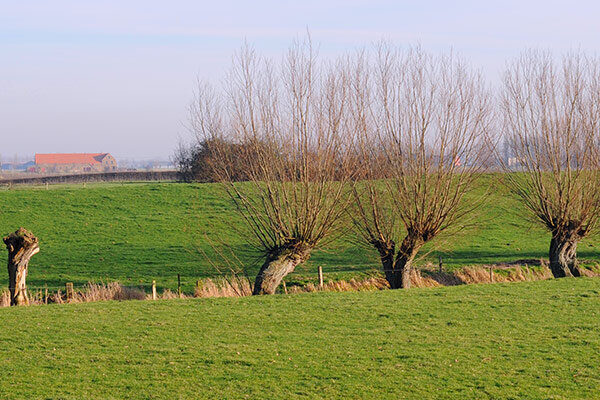Pollarding: Why We Do it, and When You Should Consider this Pruning Technique
One of the services that we offer the Kalamazoo community is tree pollarding – something that many people haven’t heard of, though it is highly likely that you have seen it. This technique is used on trees in many different kinds of locations, helping to shape them so that the trees stay healthy and safe.
Pollarding, as defined by Horticulture Magazine, is: “when young trees and shrubs are cut to the main stem or trunk, ultimately controlling the height of the plants. This is different from coppicing because the trees and shrubs are not cut at ground level, but much higher, usually around six feet. Pollarding maintains a desired height for the plants, reduces shade and defines the plants’ shape. This method is also employed to prevent tall trees from obstructing electrical wires and phone lines when planted near streets.”
If you are interested in pollarding and finding out more information, read on.
What is Pollarding?
So just what is pollarding and why do we do it? When a tree care professional pollards a tree, we cut off the central leader of the tree first, and then we cut all of the branches that are around the same height. This helps to shorten the crown of the tree. We try to keep the height of the tree at least six feet above the ground for safety AND to keep animals from grazing.
Pollarding also removes lower limbs and any crossing limbs – which is a typical part of tree pruning. While it may look silly at first or like your tree has been destroyed, you will soon see a thick crown growing back. This is why it is so important to pollard young trees – older trees will take longer to grow back in and fill with greens.
Pollarding typically takes place when the tree is dormant, so while that will vary from tree to tree, it is most common during the early spring months or winter.
According to Gardening Know How, it also makes your trees less susceptible to getting a disease or fungus.
What Trees Can We Pollard?
Whether or not a tree care professional can pollard your tree depends on your trees, your space, and the age of your trees. Like previously mentioned, it is better to pollard younger trees because they will come back much more quickly than older trees.
This is a list of trees that are commonly pollarded from the Royal Horticulture Society:
- Ash (Fraxinus)
- Common lime (Tilia × europaea)
- Elm (Ulmus)
- Elder (Sambucus)
- Gum (Eucalyptus)
- London plane (Platanus × hispanica)
- Mulberry (Morus)
- Oak (Quercus)
- Some species of Acer (A. negundo and its cultivars)
- Tulip tree (Liriodendron)
Remember that all trees need to be handled on a case by case basis and just because you have a tree that is one of the types listed above, you can have your trees pollarded. The best thing that you can do is reach out to a tree care professional and get his or her opinion.
Why We Do It
There are many reasons why people get their trees pollarded. They do so because their trees are unsafe in such a small space, they do so because they want their trees to fit into their landscaping better, maybe they do so because the tree isn’t growing in a way that is sustainable.
The history of pollarding has been explained by SF Home Guides: “Historically, Europeans pollarded and coppiced trees to produce quick wood growth for kindling, fencing and basket-making. Nowadays, pollarding keeps tree branches from interfering with electrical wires and obstructing pedestrian and vehicular traffic. It is also used to keep large trees smaller than normal and reduce the shade they cast. The new growth on some trees is colorful, with pollarding producing constantly fresh branches.”
When You Should Consider This Technique
You should consider this technique if you feel like your trees are growing tootall or that they are unsafe because they are so top heavy. You should also consider if you feel like your trees are getting too close to other important items in your yard – electrical wires, poles, trees, or structures.
According to The Spruce, we do need to remember that there is a difference between pollarding and topping – pollarding is almost always done on younger trees.
Another thing to consider is that once you start to pollard a tree, you should keep up with it regularly. This doesn’t mean that you will have more maintenance for your trees, but typically we do this when you need it for space or safety reasons. Sometimes, it will be part of landscape design, but that isn’t as common.
Pollarding needs to happen every couple years to every five years or so. A tree care professional will be able to tell you how often you should pollard your tree.
Whether you have one tree, many trees, or somewhere in between, pollarding is a pruning technique that all Kalamazoo tree tenders should consider. However, you do not want to do this by yourself. Instead, you want to contact a tree care professional who can do it for you – and do it the right way. If it is done incorrectly, you could put your trees in danger.
We can help you take care of your trees -everything from regular maintenance to see if your tree is experiencing any problems or with the pollarding cutting of your trees. If you are having any tree care problems at all, you can give us a call and we will work with you to keep your trees and yard healthy.
Give us a call today at (269) 216-6811 and we can set up a time to visit you and your trees.


